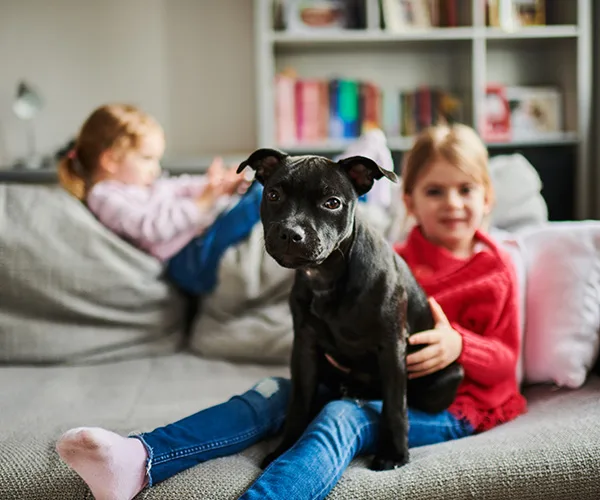Thinking about adding a furry friend to your family? Well now’s the time to make it a reality!
You and your family could help an animal in need of a safe and happy home, but which pet is best? There are all sorts of myths floating around that rescue animals are aggressive, dangerous creatures to have in the home, but that couldn’t be further from the truth.
We spoke to pet behaviourist Dr Kate Mornement and Vickie Davy, the founder and partnership and programs lead from PetRescue about what to know before adopting a pet and some common misconceptions about certain dog breeds.

Liam Hemsworth (and his wife Miley Cyrus) are big advocates for rescuing animals and here’s why you should be too! (Image: Instagram @liamhemsworth)
Why adopt?
While that puppy or kitten in the pet shop window looks cute, there are quite a few reasons why you should head to the pound instead.
Puppies and kittens are babies and despite their adorable faces, they are untrained, unsocialised and need a lot of work.
Meanwhile, rescue animals tend to be older and because they’ve matured, the good people at the pound know what their personalities are like and can find a little someone who will fit in well to your home whether you live alone or have a family of young children.
While there is no nationally kept data on pound surrenders (which makes it incredibly hard to look at ways to help people keep their pets),there are many reasons pets are left at the pound.
“Most pets coming into the system have been loved pets, but owner circumstances have changed, and they can’t look after them anymore,” explains PetRescue’s Vicky Davy.
“Financial hardship, loss of a job, lack of rental accommodation that will allow pets, owner health issues or elderly people going into care are all common reasons. There are also pets that have been obviously loved and cared for, but their owner doesn’t come to claim them. This suggests that either something has happened to the owner or the owner simply doesn’t know how the system works or where to look for their pet.”
WATCH: Patrick Stewart has adopted a pit bull. Post continues after video…
Which animal is best?
Woohoo, you’ve made the decision to adopt a pet! So which one do you go for?
Seeing as all adoptable pets have been health-checked as well as assessed for temperament, basic manners and toilet training, the staff and volunteers at reliable rescue organisations can help you find the perfect companion that suits your lifestyle.
For families with young children, pet behaviourist Dr Kate would recommend choosing a kitten, a cat or a small to medium sized dog, as larger dogs can accidentally knock the little ones of their feet…quite literally.
“Cats and dogs make great pets for young children and it’s important to go and meet the pet to make sure they’re not scared of, or too boisterous with, the children and vice versa,” she says.
“Children and pets should be taught and encouraged to interact in an appropriate and gentle manner and should always be supervised when together. Sometimes young children can be a little overwhelming for pets, so having a place in the home where pets can escape to for some time on their own is important.”

Children need to be taught to be appropriate and gentle when interacting with pets. (Image: Getty Images)
Breeds you may think are dangerous but aren’t
Stereotyping people is a big no-no, and dogs are no different.
There are certain breeds of animals, especially dogs, that people may think are aggressive and not suitable to live with people but Dr Kate is here to clear that up.
“Dog breeds like Mastiffs, Staffies, German Shepherds, Dobermans and Rottweilers are considered dangerous by some people and Pit Bulls are currently banned in Australia,” she explains.
“However the vast majority of these dogs make wonderful companions and are not dangerous to the community when raised in a loving home and trained and socialised properly.”
Don’t be fooled by the rumours! (Image: Instagram @petrescueau)
How can you help animals in need if you can’t adopt?
For some of us, there is no way we can let a furry friend into our homes whether it’s due to allergies, tricky landlords or just a hectic lifestyle. But there are plenty of ways to help out animals in need, just ask Vicky!
You can donate to or fundraise for an animal welfare program, volunteer for your local rescue organisation (and if you have business, admin and social media skills to share, even better!), foster a pet, or even encourage your workplace to join PetRescue’s Workplace Foster Care Program. Because who doesn’t want an office dog or cat?
“Additionally, a huge difference can be made by simply becoming an adoption ambassador. Go to our website and share pet profiles on your social media, talk to your friends and family about how wonderful rescue pets are, and best of all take some friends to the PETstock National Pet Adoption Day to pat, cuddle and let them fall in love!”
Want more tips and tricks for your pets? Check out the links below!
Dog breeds you may think are dangerous but are actually great to adopt as pets
50 names for black dogs that couldn’t be more perfect
Does my dog have depression? Nine mental health signs to watch in your pets
Royal pets: The posh pooches (and ponies and cats) that keep this regal family company
The best cat for you, based on your star sign
Five pet adoption tips from Dr. Chris Brown
What your dog can and can’t eat: don’t feed your dog raw chicken meat
See the most adorable photos ever of celebrities and their pets
Puppy guide 101: Four things every new dog owner should know
.jpg?fit=900%2C751)

.png?resize=380%2C285)
